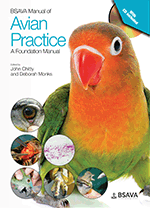
Full text loading...

Feather loss is a common presentation in avian practice. While few disorders resulting in feather loss are genuine emergencies, they are often perceived as such by owners. Issues with husbandry or disease may result in feather destructive disorder. This chapter covers types of feather loss, common causes and diagnostic work-up and highlights areas of debate in feather loss examination and management. Case examples: Plucking in an African Grey Parrot; Dermatitis in an Amazon parrot; Red feathers in an African Grey Parrot.
Feather loss, Page 1 of 1
< Previous page | Next page > /docserver/preview/fulltext/10.22233/9781910443323/9781910443323.30-1.gif

Full text loading...

























